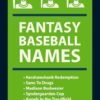Fantasy Baseball Trade Value Chart: A Strategic Tool for Fantasy Team Managers
Fantasy baseball trade value charts are valuable resources that help fantasy team managers assess the relative worth of players in trades. In the world of fantasy sports, trades are a common occurrence, allowing managers to strengthen their rosters by acquiring players who can contribute to specific categories or fill positional needs. By using a trade value chart, managers can make informed decisions that enhance the competitiveness of their fantasy teams. In this article, we will explore the significance of fantasy baseball trade value charts, how they work, and the strategic advantages they offer to managers.
Understanding Fantasy Baseball Trade Value
Determining Player Worth
A fantasy baseball trade value chart is essentially a ranking system that assigns a numerical value to each player based on their perceived worth in the context of the league’s scoring system and player performance. These values help managers gauge the potential impact a player might have on their team’s overall performance in various statistical categories, such as batting average, home runs, runs batted in (RBIs), stolen bases, and pitching statistics like wins, strikeouts, and earned run average (ERA).
Making Informed Trade Decisions
Strategic Team Building
By consulting a trade value chart, fantasy team managers can assess whether a trade proposal benefits their team and aligns with their strategic goals. For example, if a manager needs to bolster their home run production, they can use the chart to identify players who rank higher in this category and target them in potential trades. Conversely, they can evaluate the impact of giving up certain players on their roster to ensure that the trade improves overall team performance.
Flexibility and Customization
Adapting to League Settings
Fantasy baseball trade value charts are versatile tools that can be tailored to the specific scoring system and settings of each league. Different leagues may prioritize different statistical categories, and trade value charts can be customized to reflect these unique preferences. This adaptability ensures that managers can make trade decisions based on the specific needs of their individual leagues.
Staying Objective in Trades
Avoiding Emotional Decisions
Trading players in fantasy baseball can evoke emotional responses from managers, especially if they have a personal attachment to a particular player or have drafted them early in the season. A trade value chart serves as an objective guide, allowing managers to assess trades based on data and analysis rather than emotional biases.
Monitoring Player Performance
Dynamic Nature of Trade Values
Trade value charts are not static and can change throughout the season based on player performances, injuries, and other factors. As players rise or fall in their fantasy baseball production, their trade values may adjust accordingly. Savvy managers keep an eye on these fluctuations to seize opportunities and make impactful trades.
Fantasy Baseball Trade Value Chart: A Strategic Asset
fantasy baseball trade value chart is an invaluable tool for fantasy team managers, providing a systematic approach to assess player worth and make informed trade decisions. By using these charts, managers can strategically build their teams, target specific statistical categories, and adapt to the unique settings of their leagues. Staying objective and informed, fantasy team managers can make trades that enhance their team’s competitiveness and maximize their chances of success in the dynamic world of fantasy baseball.


